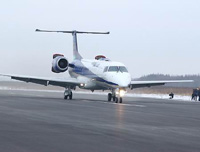
China-made feeder liner ERJ145, the once-promising product in China's aviation market, now meets Waterloo in the battle to get more orders and faces the threat to stop production.
Chinese aviation experts said the unexpected result exposes China's soft spots in feeder line transport and incomplete governmental policies on developing feeder line transport in the country.
Aviation experts said China is still a market in strong demand for feeder liners.
China's air transportation is surging rapidly at an annual rate of 18 percent since 1978, and more than 90 feeder liners have been built in China's medium-scale cities in recent years, indicating an increasing demand for feeder liners.
Currently, there are only 74 feeder liners available in China. Statistics show that in the coming two decades, more than 600 feeder liners will be needed in China, and the demand from the international feeder line transport market will exceed 4,000.
To meet the demand, China's State Council decided in February 2000, to establish a joint venture with the Brazil-based aero-maker Embraer to produce 30-70 seats feeder liners in China.
In January 2003, the China Aviation Industry Corporation II and the Embraer made an joint investment of 40 million US dollars for the new Harbin Embraer aircraft industry Co., and started the making Embraer's star product--the 30-50 seat ERJ145--in China.
According to the contract, aircraft components for the ERJ145 will be localized in China gradually and try to produce enough airplanes to meet China's demand in the period between 2006-2010.
Jiang Da, vice general manager of Harbin Embraer, said ERJ145 airplane indeed had a good start in China with an order of six from the China southern Airlines and another order of ten from the China Eastern Airlines in 2004.
But in case of losses in the feeder line transport, most Chinese airlines lowered their interests on feeder line transport in the following year.
Jiang said though the six ERJ145 have been delivered to the China Southern Airlines, the China Eastern Airlines only bought five of their order by now.
And no more new orders were clinched by Harbin Embraer in China after that, said Jiang.
An investigation from the China National Civil Aviation Administration (CNCAA) said that most Chinese airlines make no profits in feeder line transport even these airplanes working more than eight hours each day with over 70 percent seats taken.
Experts said China's limited supporting policies on feeder line transport is far to stimulate more demand from the Chinese airlines in expanding feeder liner market.
Statistics show that the share of feeder liners among China's total fleet still less than 10 percent, while the proportion in the United States is 50 percent.
Besides the low profit and shortage of airplanes, other reasons for the low-development of feeder line transport in China was that the cost of operating feeder line transport is much higher than that on trunk lines, said some Chinese airlines.
Currently, many Chinese airports, including Beijing, Shanghai and Kunming, have to limit the entry of feeder liners in case of tense landing areas, which added more pressure on Chinese airlines in developing feeder line transport.
To change the unsatisfactory situation, the CNCAA has just issued guidelines on promoting the development of the feeder line transport in China.
According to the guidelines, airline companies would be given an easier access to feeder line transport. Favorable policies and government subsidies would also be given to transporters on feeder lines and airport operation.
In promoting the aviation development on short-distance flight routes and in lacklustered regions, CNCAA promised to simplify the approval procedure of buying and renting feeder liners, and relax import tax on the feeder liners, engines, and component.
Hu Huaqing, a researcher with the Chinese cavil aviation development institute, suggests that the aviation authorities should allow some airlines to launch more business feeder lines on tourism, point-to-point route. In addition, some new air companies and new airports should be defined wholly to operate feeder line transport.
(Xinhua News Agency January 18, 2006)
|

